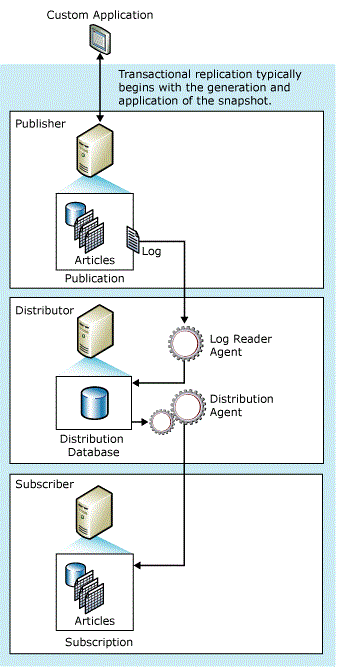Transactional Replication in SQL Server 2008:Transactional replication will start with a snapshot of the publication database objects and data which is called as initial snapshot. Subsequent data changes and schema modifications made at the Publisher are usually delivered to the Subscriber as they occur (in near real time). The data changes are applied to the Subscriber in the same order and within the same transaction boundaries as they occurred at the Publisher; therefore, within a publication, transactional consistency is guaranteed.
By default, Subscribers to transactional publications should be treated as read-only, because changes are not propagated back to the Publisher. However, transactional replication does offer options that allow updates at the Subscriber.
Transactional replication is implemented by the SQL Server Snapshot Agent, Log Reader Agent, and Distribution Agent. The Snapshot Agent prepares snapshot files containing schema and data of published tables and database objects, stores the files in the snapshot folder, and records synchronization jobs in the distribution database on the Distributor.
The Log Reader Agent monitors the transaction log of each database configured for transactional replication and copies the transactions marked for replication from the transaction log into the distribution database, which acts as a reliable store-and-forward queue. The Distribution Agent copies the initial snapshot files from the snapshot folder and the transactions held in the distribution database tables to Subscribers.
Incremental changes made at the Publisher flow to Subscribers according to the schedule of the Distribution Agent, which can run continuously for minimal latency, or at scheduled intervals. Because changes to the data must be made at the Publisher (when transactional replication is used without immediate updating or queued updating options), update conflicts are avoided. Ultimately, all Subscribers will achieve the same values as the Publisher. If immediate updating or queued updating options are used with transactional replication, updates can be made at the Subscriber, and with queued updating, conflicts might occur.
The figure below shows typical configuration of transactional replication for Push Configuration.

Before a new transactional replication Subscriber can receive incremental changes from a Publisher, the Subscriber must contain tables with the same schema and data as the tables at the Publisher. The initial dataset is typically a snapshot that is created by the Snapshot Agent and distributed and applied by the Distribution Agent.
When snapshots are distributed and applied to Subscribers, only those Subscribers waiting for initial snapshots are affected. Other Subscribers to that publication (those that have already been initialized) are unaffected.
Concurrent Snapshot Processing
Transactional replication by default does not hold the share locks in place during the entire snapshot generation, which allows users to continue working uninterrupted while replication creates initial snapshot files.
Snapshot Agent
The procedures by which the Snapshot Agent implements the initial snapshot in transactional replication are the same procedures used in snapshot replication except that it does not a shared lock on the tables/articles in transactional replication. After the snapshot files have been generated, you can view them in the snapshot folder using Microsoft Windows Explorer.
Modifying Data and the Log Reader Agent
The Log Reader Agent runs at the Distributor which typically runs continuously, but can also run according to a schedule you establish. When executing, the Log Reader Agent first reads the publication transaction log and identifies any INSERT, UPDATE, and DELETE statements, or other modifications made to the data in transactions that have been marked for replication.
Next step is that the agent copies those transactions in batches to the distribution database at the Distributor. The Log Reader Agent uses the internal stored procedure sp_replcmds to get the next set of commands marked for replication from the log. The distribution database then becomes the store-and-forward queue from which changes are sent to Subscribers.
Note that only committed transactions are sent to the distribution database.
After the entire batch of transactions has been written successfully to the distribution database, it is committed. Following the commit of each batch of commands to the Distributor, the Log Reader Agent calls sp_repldone to mark where replication was last completed. Finally, the agent marks the rows in the transaction log that are ready to be purged. Rows still waiting to be replicated are not purged.
Transaction commands are stored in the distribution database until they are propagated to all Subscribers or until the maximum distribution retention period has been reached. Subscribers receive transactions in the same order in which they were applied at the Publisher.
Distribution Agent
The Distribution Agent runs at the Distributor for push subscriptions and at the Subscriber for pull subscriptions. The agent moves transactions from the distribution database to the Subscriber. If a subscription is marked for validation, the Distribution Agent also checks whether data at the Publisher and Subscriber match.
The Steps involved in Setting up Transactional Replication are:
1. Configuring Distribution
2. Publishing Data and Database Objects
3. Subscribing to Publications
4. Initializing a Subscription
5. Synchronizing Data
The Step by Step Setup of Transactional Replication will posted soon.
